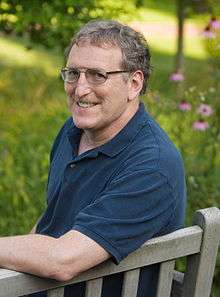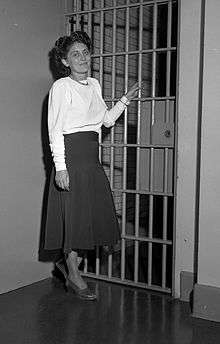Maurice Isserman
Maurice Isserman (born 1951), formerly William R. Kenan and the James L. Ferguson chairs, is a long-time Professor of History at Hamilton College and important contributor to the "new history of American communism" that reinterpreted the role of the Communist Party USA during the Popular Front period of the 1930s and 1940s. His books have also traced the emergence of the New Left and the 1960s. He co-authored a biography of Dorothy Ray Healey and wrote an award-winning biography of the American socialist leader Michael Harrington.[1][2] Recently, he refocused his work on the history of mountaineering in the Himalayas and the United States. He has contributed editorials and book reviews to The New York Times, The Boston Globe, Newsday, the Los Angeles Times, The Nation, and The American Alpine Review.
Maurice Isserman | |
|---|---|
 Isserman in 2008 | |
| Born | March 12, 1951 |
| Academic background | |
| Alma mater | |
| Doctoral advisor | Eugene Genovese |
| Academic work | |
| Discipline | History |
| Institutions | Hamilton College |
| Main interests |
|
Early life
Isserman was born in Hartford, Connecticut, on March 12, 1951, into a family that would have significant influence on his political and intellectual future. His mother, born Flora Huffman, was the daughter and sister of Quaker ministers, graduated from a Quaker college, and was a social worker for Connecticut. His father, Jacob (Jack) Isserman, was born in Antwerp and came with his family to the US in 1906 at four; later naturalized as a US citizen, he was a machinist who worked at the Pratt and Whitney aircraft factory in East Hartford, Connecticut.
The Issermans were Jewish; Maurice's uncle, Ferdinand Isserman, was a prominent rabbi in St. Louis, Missouri. Another uncle, lawyer Abraham J. Isserman, was member of the International Juridical Association (1931), founding member of the National Lawyers Guild (1937), and member of the American Civil Liberties Union and was also one of the lawyers in the first Smith Act trial in 1949 during which he was cited for contempt and then imprisoned afterwards and disbarred.[3] He also argued for the petitioners in Dennis v. United States.
Isserman's parents had divorced in 1959, and his mother remarried Walter Snow, a local newspaper reporter who had been a Communist in the 1930s, a minor figure on the literary left (John Reed Club member, and the editor of The Anvil, a Midwestern radical literary magazine). They lived in the small town of Coventry, Connecticut, and Isserman graduated from Coventry High School in 1968.
After his father's death in 1963, Maurice became close to his uncle Abraham, who took him to one of his first demonstrations, the 1967 March on the Pentagon.[4]
Education
In the fall of 1968, Isserman enrolled in Reed College in Portland, Oregon, where he joined the campus chapter of Students for a Democratic Society and took part in antiwar protests and other New Left activism. In the spring of 1970, following the US invasion of Cambodia and the Kent State University strike, he dropped out of Reed College and joined the Portland Revolutionary Youth Movement (PRYM) collective. PRYM members were involved in antiwar activities in a local underground newspaper, The Willamette Bridge, and in the local food co-op. After a couple of years, PRYM disbanded, and Isserman returned to Reed to finish his undergraduate degree. He wrote a senior thesis on the history of radical American writers in the 1930s and worked on another underground newspaper, The Portland Scribe.[5] He graduated with a BA in history in 1973 and stayed on another year, working evenings as a proofreader for The Oregonian and days (unpaid) for The Portland Scribe.
In August 1974, Isserman began graduate work in history at the University of Rochester, working closely with Eugene Genovese and Christopher Lasch. He received his MA in American history in 1976 and his PhD in 1979. His dissertation was a history of American communism during the Second World War,[6] which became his first published book, Which Side Were You On? in 1982.
Academic career

After completing his dissertation, Isserman began the itinerant career of the young scholar. His first job was a replacement position for a semester at Oberlin College in fall 1979, followed by replacement positions at Hobart and William Smith Colleges and then back to Oberlin. He settled into Smith College from 1982 to 1988, followed by temporary positions at Mount Holyoke College and Williams College.
During this period, a debate broke out over the character of American communism, and Isserman's book was one of several criticized by Theodore Draper's two-part attack on the "new history of American Communism" in The New York Review of Books.[7] As the debate heated up, Isserman criticized books by Draper's protégé, Harvey Klehr.[8][9] Isserman returned to the theme with a chapter on the history of the CPUSA's "destalinization crisis" in his second book on the emergence of the New Left, If I Had a Hammer in 1987, and in his co-authored work with Healey, Dorothy Healey Remembers, in 1990 (reissued in paperback as California Red).
Isserman secured a tenure-track position at Hamilton College in 1990, and has remained there since, currently as the James L. Ferguson Professor of History. After the debate over American communism, Isserman shifted his focus to the history of conflicts between left and right during the 1960s in his book with Michael Kazin, America Divided: The Civil War of the 1960s, now in its third edition. He wrote a prize-winning biography of America's best known socialist of his time, Michael Harrington, leader of the Democratic Socialists of America. Acknowledging the archival revelations following the fall of the Soviet Union, Isserman has credited Klehr and his coauthors with adding an important chapter on espionage to the history of the Communist Party USA.[10]
Isserman has also criticized the new Students for a Democratic Society for romanticizing the leadership of the Weatherman faction of the old SDS.[11] In recent years, Isserman has turned to his love of mountaineering to find a fresh focus for his work[12] and wrote Fallen Giants: The History of Himalayan Mountaineering[13] with Stewart Weaver, acclaimed as the "authoritative history" of the subject,[14] and Continental Divide: A History of American Mountaineering, about mountaineering in the United States. [15] He is also writing a history of Hamilton College for its bicentennial in 2012.
Isserman has participated in an exchange at the University of Sussex in fall 1985, a Mellon fellowship at Harvard University, 1992–1993, a Fulbright Distinguished Professorship at the University of Moscow, spring 1997, and an exchange at Pembroke College, Oxford University, fall 2001.
Personal
In his 1993 book Which Side Were You On?, Isserman defines "communazi" as an American political neologism, "coined by a reporter" that conflates both Communism and Nazism as the same because they were essentially totalitarian, whether left or right in belief.[16]
Isserman pursues a passion for mountain-climbing, about which he has written the award-winning book Fallen Giants.
He is married and has two children.
Awards
- 2008: National Outdoor Book Award, Fallen Giants (with Stewart Weaver).
Works
Books
- Which Side Were You On? The American Communist Party during the Second World War (1982; University of Illinois Press, 1993). ISBN 978-0-252-06336-7[16]
- If I Had a Hammer... The Death of the Old Left and the Birth of the New Left (Basic Books, 1987). ISBN 0-465-03197-8
- Dorothy Healey Remembers: A Life in the American Communist Party, with Dorothy Healey (Oxford University Press, 1990). ISBN 0-19-503819-3 Reprinted in paperback as California Red: A Life in the American Communist Party (University of Illinois Press, 1993). ISBN 978-0-252-06278-0
- America Divided: The Civil War of the 1960s, with Michael Kazin, third ed. (2000; Oxford University Press, 2007). ISBN 0-19-516047-9
- The Other American: The Life of Michael Harrington (Public Affairs, 2000). ISBN 1-58648-036-7
- Fallen Giants: The History of Himalayan Mountaineering from the Age of Empire to the Age of Extremes, with Stewart Weaver (Yale University Press, 2008)
- Continental Divide: A History of American Mountaineering, (W.W. Norton & Company, 2016)[17]
Articles
On October 20, 2017, Isserman contributed to "Red Century," a New York Times centenary series about the Bolshevik Revolution, with the article "When New York City Was the Capital of American Communism."[18]
- "How Old is the New SDS?" The Chronicle of Higher Education (October 19, 2007)[19]
- "The Flower in the Gun Barrel," The Chronicle of Higher Education (October 19, 2007)[4]
- "3 Days of Peace and Music, 40 Years of Memory," The Chronicle of Higher Education (October 19, 2007)[20]
- "When New York City Was the Capital of American Communism," New York Times "Red Century" series (October 20, 2017)[18]
See also
Notes
- "Maurice Isserman: Hamilton College Professor of History". Hamilton College. 18 August 2008. Retrieved 28 November 2016.
- "Isserman Interviewed by Former Secty. of Education Bennett". Hamilton College. 18 August 2008. Retrieved 28 November 2016.
- Isserman, Which Side Were You On?, p. xiv.
- Isserman, Maurice (19 October 2007). "The Flower in the Gun Barrel". The Chronicle of Higher Education. The Chronicle of Higher Education: B14–B15. Retrieved 26 October 2017.
- Maurice Isserman, "1968 and All That: Radicals, Hippies and SDS at Reed," Reed Magazine, Winter 2007, pp. 26–30.
- Maurice Isserman, "The 1956 Generation: An Alternative Approach to the History of American Communism," Radical America, Vol. 14, No. 2, March–April 1980, pp. 43–51.
- Theodore Draper, "American Communism Revisited," The New York Review of Books, May 9, 1985, pp. 32–37; and "The Popular Front Revisited," The New York Review of Books, May 30, 1985, pp. 44–50.
- Maurice Isserman, "Communist Caricature," In These Times, April 4–10, 1984, pp. 18–22 (review of Klehr's The Heyday of American Communism).
- Maurice Isserman, "Notes from Underground," The Nation, June 12, 1995, pp. 846–856. (review of Klehr's The Secret World of American Communism).
- Maurice Isserman (May 9, 1999). "They Led Two Lives". The New York Times. Retrieved 2008-09-13.
- Maurice Isserman, "How Old is the New SDS?" The Chronicle of Higher Education, March 2, 2007, pp. B10–B11.
- Maurice Isserman (July 3, 2007). "Himalayan Summitry: A Lesser Peak, Not a Lesser Lesson". The Christian Science Monitor. Retrieved 2008-09-13.
- Bruce Barcott (September 28, 2008). "On Top of the World: A comprehensive history of Himalayan mountaineering". The New York Times Book Review. Retrieved 2008-11-03.
- Al Alvarez, "Getting High on the Himalayas," The New York Review of Books, July 2, 2009, pp. 27-29.
- Gregory Crouch (April 16, 2016). "Maurice Isserman's 'Continental Divide'". The New York Times. Retrieved 2019-04-30.
- Isserman, Maurice (1993). Which Side Were You On?: The American Communist Party During the Second World War. University of Illinois Press. pp. 44, 76, 79, 115. Retrieved 31 December 2018.
- Isserman, Maurice; Weaver, Stewart (2008). Fallen Giants: The History of Himalayan Mountaineering from the Age of Empire to the Age of Extremes. Yale University Press. ISBN 978-0-300-11501-7. Retrieved 31 December 2018.
- Isserman, Maurice (20 October 2017). "When New York City Was the Capital of American Communism". New York Times. Retrieved 26 October 2017.
- Isserman, Maurice (2 March 2007). "How Old is the New SDS?". The Chronicle of Higher Education. The Chronicle of Higher Education. Retrieved 26 October 2017.
- Isserman, Maurice (10 August 2009). "3 Days of Peace and Music, 40 Years of Memory". The Chronicle of Higher Education. The Chronicle of Higher Education. Retrieved 26 October 2017.
External links
- Maurice Isserman's Homepage at Hamilton College
- Interview with Maurice Isserman by Stephen McKiernan, Binghamton University Libraries Center for the Study of the 1960s